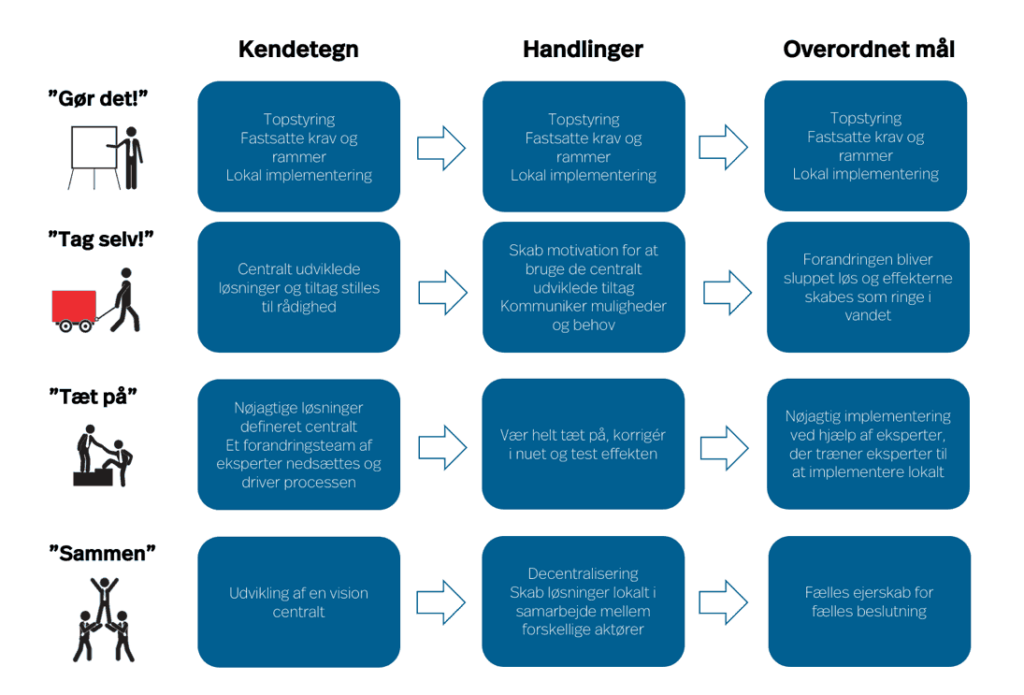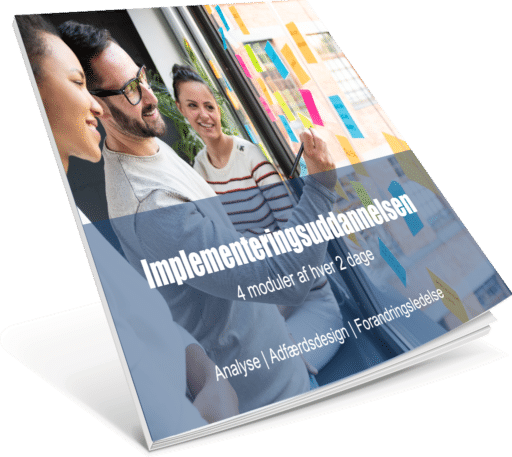4 approaches to getting to the finish line
It's one thing to formulate a strategy and make a plan. It's another to translate the strategy and plans into concrete actions on a day-to-day basis. It's in the last part, the implementation phase, where organizations typically go wrong when change fails. Implementing change is far from easy, but if you take the right approach from the start, you'll be well on your way.
Choose an approach that fits the situation
Do you always reach for the same toolbox when implementing change? If so, you're not alone. Many managers go straight to creating an implementation plan that draws on the methods and approaches they know and that worked for the last change. However, it's far from certain that the exact same approach will work in this particular situation. Therefore, don't forget to do an initial analysis before choosing your approach, methods and tactics.
Start by analyzing and setting goals
As a manager or consultant, you need to be able to drive results through implementation. You need to ensure that decisions are translated into behavior and translate into concrete actions among employees. This requires you to set a clear direction and create the right conditions for change in the organization.
Therefore, start by getting clear on the goal, the target group, the culture in which the changes are to be implemented and the desired results. This is a prerequisite for successful implementation. In addition, you need to convert the overall goals into behavioral goals: What do we really want employees to do differently? And how do we succeed?
Once you've done the analysis and can answer those questions, you'll have a qualified basis for choosing the implementation approach and creating the plan that works and creates the desired results in this particular situation.
We have defined four main approaches that you should consider and differentiate between when implementing a change.
Choose from four implementation approaches
The four approaches to implementation are grouped by characteristics, purpose, strengths and pitfalls that invite different ways of approaching implementation. Here is a summary of the different approaches:
1: "Do it!" - "Just do it!"
This is a top-down approach where frameworks and requirements are set centrally. It's good when you need quick execution and compliance and when you have a strong political mandate. A common pitfall is that management can't create enough local support, so this should be a point of attention when choosing this approach.
2: "Do-it-yourself" - "Go ahead and pick up!"
In this approach, solutions are created centrally and made available to the local units by management. It is effective when there is a need to create ownership and commitment, when there is freedom of methodology and when there are fewer compliance requirements. A common pitfall of this approach is that solutions can end up gathering dust on shelves and not being used, so it's important to stay focused on creating motivation.
The article continues below the next section. You can also read more about the first steps to successful implementation here.
Want to be even better equipped to work with implementation approaches?
LEAD's implementation training gives you the methods to design, facilitate and lead strategic implementation processes and changes to create the impact you need.
This is an education for those who work with development, processes and change management.
Learn more about our research-based implementation training
3: "Close to" - "We only leave when it works!"
This approach is based on centrally developed solutions where a dedicated project organization is set up to drive implementation. This approach is good when there is a need for extensive changes, complex solutions and when something precise and very specific needs to be implemented. Be careful to avoid it becoming too resource-intensive and difficult for the project organization to pull out again.
4: "Together" - "We do it together!"
Here, you define an overall goal centrally, and then motivate professionals to work together to develop the paths to get there. This means that the solutions are developed locally in close collaboration between different stakeholders - with central support for local initiatives. This approach works well when there is a need for innovation and when the mandate can be distributed. Be aware that it can be difficult to make decisions and ensure progress, especially if a clear champion is not defined.
The model summarizes what characterizes the approaches as well as what actions are needed and what the goal of the approach is.
Creating a strong leadership chain is a collective effort that requires both a common leadership language and synchronization of organizational practices. But the effort is worth the resources in terms of strengthened leadership and organizational coherence - and ultimately better results for the organization.
Read our article on how to identify stakeholders in a change process here.


Do you want to be better at:
- Plan and execute projects that don't get derailed or scrapped halfway through
- Create greater positive measurable impact from your implementations
- Create motivation, engagement and followership among your stakeholders
- Translate strategies and decisions into behavioral goals
- Work continuously with concrete behavioral changes
- Dealing with resistance from those involved
- Use learning and benefit realization as an integral part of your implementations
Then fill out the form below and receive our description of the research-based implementation training that gives you the most powerful tools for implementation in practice.




